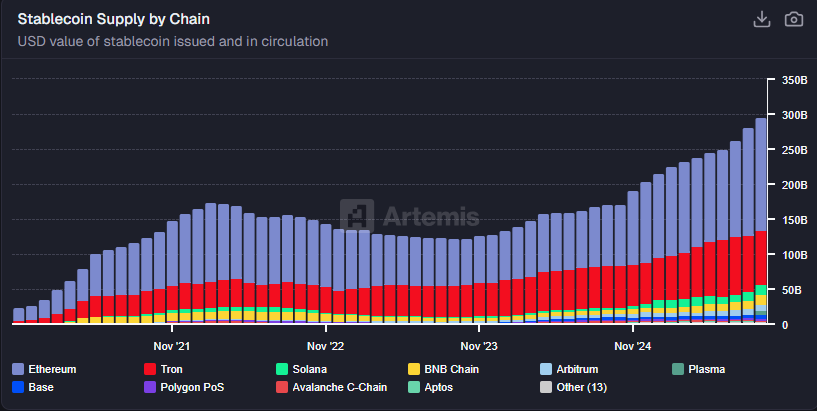The Bank for International Settlements (BIS) has cautioned that stablecoin yield products pose significant risks by blurring the boundaries between payment mechanisms and investment vehicles, potentially exposing users to losses without adequate safeguards like deposit insurance or regulatory oversight.
-
BIS highlights how yield features in stablecoins compete with traditional bank deposits but lack equivalent protections.
-
Stablecoin supply has surged to over 305 billion tokens, held across 42.1 million addresses, with growing adoption in yield-generating apps.
-
Conflicts of interest arise as stablecoin issuers and protocols offer higher yields than banks, often without consumer protections or transparency.
Discover BIS warnings on stablecoin yield products: risks of unregulated yields blurring payments and investments. Protect your crypto assets—explore safeguards now.
What Are the Risks of Stablecoin Yield Products According to BIS?
The Bank for International Settlements (BIS) has issued a stark warning regarding stablecoin yield products, emphasizing that integrating yield mechanisms into these digital assets fundamentally alters their role from simple payment tools to investment-like instruments. This shift, as outlined in the BIS’s recent analysis, introduces vulnerabilities such as inadequate prudential oversight and the absence of deposit insurance, leaving users susceptible to potential financial losses. With stablecoin total supply reaching 305.9 billion tokens distributed across 42.1 million addresses—a 4% increase in the past month—these products are gaining traction, but the BIS urges greater caution to mitigate emerging risks.
How Do Stablecoin Yield Products Create Conflicts with Traditional Banking?
Stablecoin yield products generate conflicts of interest by offering attractive returns that rival or exceed those of conventional bank deposits, yet they operate without the stringent regulatory frameworks that protect traditional savers. The BIS report details how these yields, often derived from investments in assets like U.S. Treasury Bills, are shared more generously with users compared to bank practices, but this comes at the cost of transparency and safety nets. For instance, protocols such as those using tokenized T-Bill products like BUIDL provide yields without the backing of federal deposit insurance, potentially treating users as unsecured creditors in case of issuer failure.
Expert analysis from the BIS underscores that decentralized crypto asset service providers (CASPs) offering these yields remain largely unregulated, exacerbating gaps in consumer protection. While stablecoin issuance itself benefits from some oversight—ensuring reserves match circulating supply—the yield layers introduce additional complexities. Higher savings rates, sometimes reaching 4% to 7% on popular platforms, draw users away from banks, but the organization warns of adverse outcomes like contractual vulnerabilities. As reported by financial outlets like Cryptopolitan, the BIS’s longstanding skepticism toward cryptocurrencies amplifies these concerns, advocating for expanded regulations to cover yield-generating protocols and prevent systemic risks to the broader financial ecosystem.
The popularity of stablecoins in lending and yield apps further complicates matters. Platforms like Aave, Morpho, Maple Finance, and Sky Protocol dominate liquidity pools, where stablecoins such as USDC are deployed for returns. However, even regulated stablecoins can end up in high-risk environments, including vaults promising aggressive APYs above 100% or even 1,000%. The BIS notes that most prudent users steer clear of such unsustainable offers, opting instead for moderate yields enhanced by incentives like airdrop farming. Over the past year, this trend has shifted user behavior toward safer, token-reward strategies rather than volatile trading, but the lack of uniform protections persists as a critical issue.
 Stablecoins expanded their total supply, while yield opportunities increased, with additional incentives coming from airdrop farming. Total stablecoin supply is above 305B tokens. | Source: Artemis
Stablecoins expanded their total supply, while yield opportunities increased, with additional incentives coming from airdrop farming. Total stablecoin supply is above 305B tokens. | Source: ArtemisIn contrast to exceptions like USDT, where issuers retain most interest from T-Bill holdings, other protocols distribute yields more equitably, fueling adoption. The BIS emphasizes that these arrangements, while innovative, undermine the stability stablecoins were designed to provide, potentially destabilizing user confidence and the payments infrastructure. Regulatory bodies are encouraged to impose standards on CASPs to ensure parity with banking norms, including transparency in yield sources and robust risk disclosures.
Frequently Asked Questions
What Regulations Currently Apply to Stablecoin Yield Products?
Current regulations for stablecoins primarily focus on reserve backing and issuance, requiring issuers to maintain equivalent assets to circulating supply, as seen with approved frameworks in major jurisdictions. However, yield products fall into a regulatory gray area, with no specific mandates for decentralized protocols offering lending or interest features. The BIS advocates for enhanced oversight to address these gaps, including rules for CASPs that mirror banking protections against failures.
Why Are Stablecoin Yields Higher Than Bank Deposit Rates?
Stablecoin yields often surpass bank deposit rates because protocols directly invest reserves in high-return assets like U.S. T-Bills and share a larger portion of the profits with users, bypassing traditional overheads. Popular platforms deliver 4% to 7% APY, boosted by incentives like airdrops, making them appealing for savers seeking better returns without venturing into volatile markets. That said, this comes without the safety of insured deposits, as highlighted in BIS analyses.
Key Takeaways
- Blurring Boundaries: Stablecoin yield products transform payment assets into investments, raising risks without corresponding safeguards like deposit insurance.
- Regulatory Gaps: While stablecoin issuance is somewhat regulated, yield protocols lack oversight, exposing users to conflicts and potential losses from issuer failures.
- Adoption Trends: With supply over 305 billion tokens and yields attracting users via airdrops, monitor developments and prioritize platforms with transparency for safer participation.
Conclusion
The Bank for International Settlements (BIS) warnings on stablecoin yield products underscore the urgent need for balanced innovation and protection in the crypto space, where yields from protocols like Aave and Morpho offer compelling alternatives to bank deposits but introduce significant vulnerabilities. As stablecoin adoption surges—with holdings in over 42 million addresses—regulators must bridge the gaps in oversight for decentralized services to safeguard users. Looking ahead, informed participation and advocacy for robust frameworks will be essential to harnessing stablecoin potential while minimizing risks in this evolving financial landscape.







